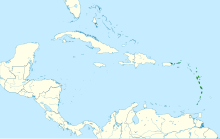Green-throated carib
| Green-throated carib | |
|---|---|

| |
| in Barbados | |
| Scientific classification | |
| Domain: | Eukaryota |
| Kingdom: | Animalia |
| Phylum: | Chordata |
| Class: | Aves |
| Clade: | Strisores |
| Order: | Apodiformes |
| Family: | Trochilidae |
| Genus: | Eulampis |
| Species: | E. holosericeus
|
| Binomial name | |
| Eulampis holosericeus | |

| |
| Synonyms | |
|
Trochilus holosericeus Linnaeus, 1758 | |
The green-throated carib (Eulampis holosericeus) is a species of hummingbird in the genus Eulampis, which contains one other species. It has two subspecies, holosericeus and chlorolaemus, the former occurring in Puerto Rico and the latter in Grenada.
Distribution & habitat
It is found in the Caribbean islands and Lesser Antilles, locations including Anguilla, Antigua and Barbuda, Barbados, Dominica, Grenada, Guadeloupe, Martinique, Montserrat, Puerto Rico, Saba, Saint-Barthélemy, Saint Kitts and Nevis, Saint Lucia, Saint Martin, Saint Vincent and the Grenadines, Sint Eustatius, the British Virgin Islands and the U.S. Virgin Islands.
Its natural habitat is semi-deciduous forests and rainforests. It will also occupy open spaces such as parks and cultivated fields.[2]
Description
The green-throated carib is a large hummingbird. Adult females have some feathers orange to light green below the peak, while adult males have light green in greater proportion. Also the tail in adult females is dark red-brown with tips ending in white, the tail of the male is dark blue. Both females and males have an intense blue band on the chest, belly of both are dark green-blue. The back of both is green with golden tones.
Behavior
Its vocalizations consist of a sharp "chup" or "tsip", which it repeats when alarmed It also produces nonvocal sounds with its wings.[3]
References
- ^ BirdLife International (2012). "Eulampis holosericeus". IUCN Red List of Threatened Species. 2012. Retrieved 26 November 2013.
{{cite journal}}: Invalid|ref=harv(help) - ^ "Green-throated Carib (Eulampis holosericeus)". Handbook of the Birds of the World. Retrieved 17 August 2016.
- ^ "Eulampis holosericeus". neotropical birds - cornell. Retrieved 17 August 2016.
External links
 Media related to Eulampis holosericeus at Wikimedia Commons
Media related to Eulampis holosericeus at Wikimedia Commons

